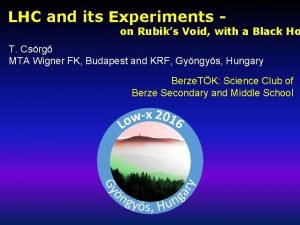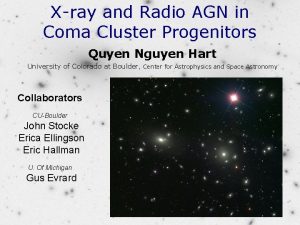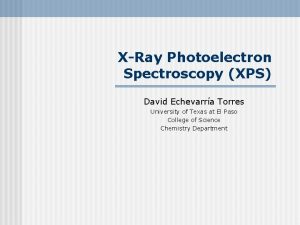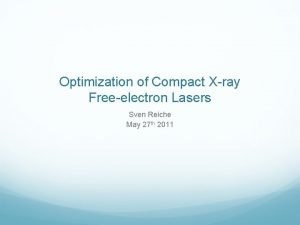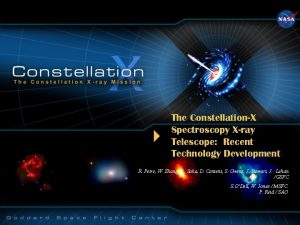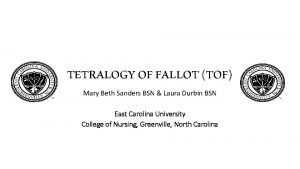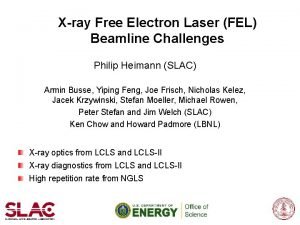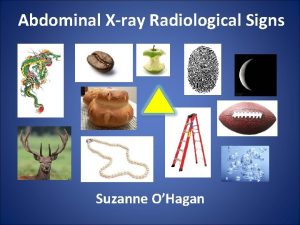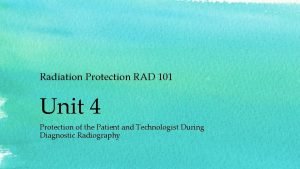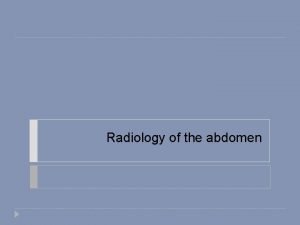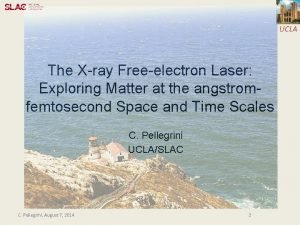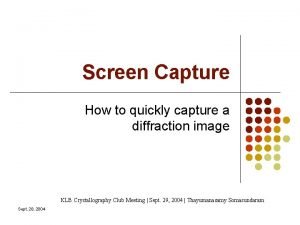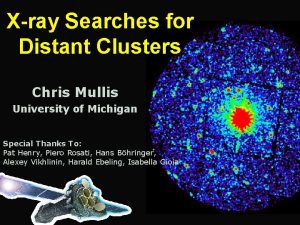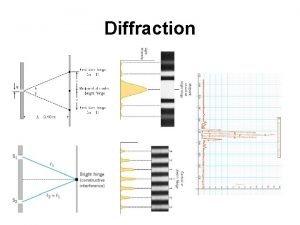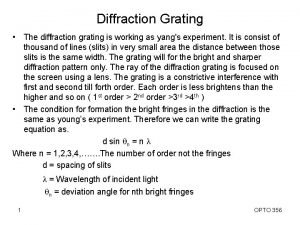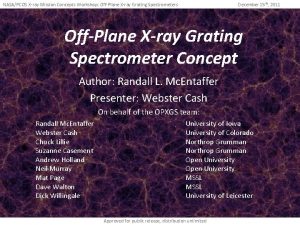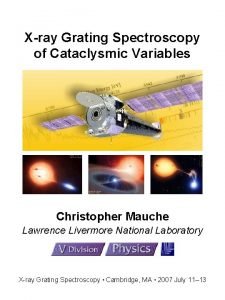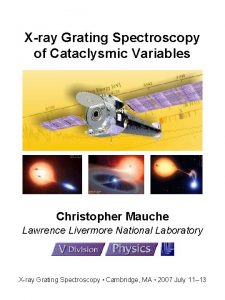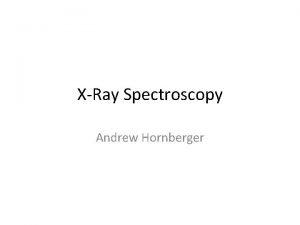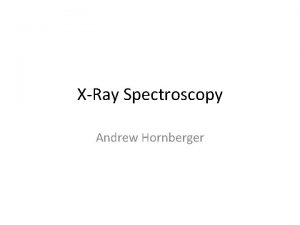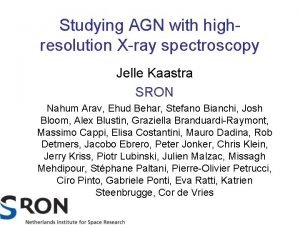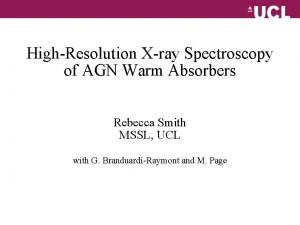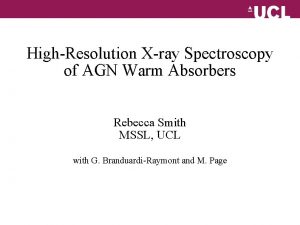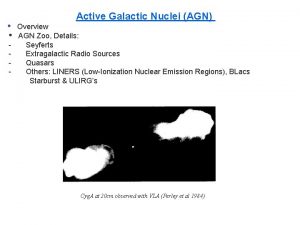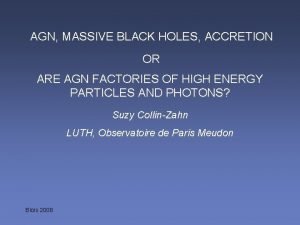Xray Grating Spectroscopy of AGN Xray Grating Spectroscopy



















- Slides: 19

X-ray Grating Spectroscopy of AGN X-ray Grating Spectroscopy Mike Crenshaw Georgia State University • • • Broad-band view X-ray spectral components: – Soft X-ray excess – X-ray NLR – X-ray warm absorber – Fe K (broad and narrow) The need for higher spectral resolution/sensitivity

X-ray Grating Spectroscopy Schematic Continuum SED for AGN IR Bump Big Blue Bump (hot dust) Soft X-ray excess Hard X-ray hump

Components of X-ray Emission Thermal component (or something else? ) X-ray Grating Spectroscopy Reflection of coronal X-rays by cold disk Compton upscattering of disk photons by hot corona (Fabian, 2006, AN, 327, 943)

Soft X-ray Excess X-ray Grating Spectroscopy XMM PN+MOS (Crummy, et al. 2006, MNRAS, 365, 1067) • Seyfert 1 s and quasars show a soft X-ray excess below 1 ke. V after subtraction of = 1. 7 2. 2 power-law. • Previously explained by a thermal component (e. g. , low-temperature Comptonization of accretion disk photons).

X-ray Grating Spectroscopy • But the excess has a fixed “temperature” (~0. 2 ke. V), suggesting an atomic rather than continuum origin (Done & Nayakshin, 2007, MNRAS, 377, L 59): 1) 2) Relativistically broadened (“blurred”) emission lines from accretion-disk reflection (Crummy, et al. 2006). High-velocity outflows of ionized gas absorbing the 0. 7 - 3 ke. V range (Done & Nayakshin, 2007; Chevallier, et al. 2006, A&A, 449, 493). 1) Reflection 2) Absorption (Fabian, 2006, AN, 327, 943) (Gierlinski & Done, 2004, MNRAS, 349, L 7)

Narrow X-ray Emission Lines 3) Another soft-excess contributor: narrow X-ray emission lines Need high-resolution grating spectra to see their effect: NGC 1068 (Kinkhabwala, et al. 2002, Ap. J, 575, 732) X-ray Grating Spectroscopy

X-ray Grating Spectroscopy • Narrow radiative recombination continua (RRC) give temperatures of 10 e. V photoionization dominates over collisional ionization (Guainazzi & Bianchi, 2007, MNRAS, 374, 1290). • In nearby Seyferts with obscured (NGC 1068) or temporarily faint (NGC 4151) central engines, the majority of the soft X-ray emission comes from an extended region roughly coincident with the NLR: CXO/HST Image of NGC 1068 (Ogle, et al. 2003, A&A, 849, 864)

X-ray Grating Spectroscopy • In addition to photoionization, photo-excitation (resonance scattering) plays an important role in producing the observed emission lines. • Turbulence can enhance this effect and boost resonance (r) lines, relative to intercombination (i) and forbidden lines in He-like triplets (Armentrout, et al. 2007, Ap. J, astro/ph 0705. 0628 - see his poster): Three-Component photoionization model for NGC 4151: Size: < 940 pc < 0. 9 pc < 0. 05 • “Low” is the extended X-ray NLR. • “Medium” and “High” similar to the warm-absorber components in NGC 4151 ( Kraemer et al. 2005, Ap. J, 633, 693). A significant fraction of the X-ray emission lines comes from warm absorbers.

X-ray “Warm Absorbers” X-ray Grating Spectroscopy (George, et al. 1998, Ap. JS, 114, 73) • • ASCA detected O VII and O VIII absorption edges in ~50% of Seyferts with X-ray absorbers also have blueshifted UV absorption (Crenshaw et al. 1999, Ap. J, 516, 750). • Blueshifted absorption lines seen by Chandra and XMM confirm mass outflow (Kaspi et al. 2002, Ap. J, 574, 643).

X-ray Grating Spectroscopy (Gabel, et al. 2003, Ap. J, 583, 178) • Similar velocity coverage for X-ray absorbers and multiple UV components. • Mass outflow rates are comparable to accretion rates (~ 0. 01 M /yr ). • Do X-ray absorbers separate into multiple narrow components, or are they more like winds?

Absorption Variability in X-rays X-ray Grating Spectroscopy NGC 4151 (Kraemer et al. 2005, Ap. J, 633, 693) • • • X-ray absorption primarily from broad UV component at vr = -500 km s-1. Deeper absorption in 2000 due to lower ionizing flux and larger NH. From variability, UV constraints: absorber is at ~0. 1 pc with v. T 2100 km s-1 (for a specific kinematic model, see Crenshaw &Kraemer, 2007, Ap. J, 659, 250).

X-ray Grating Spectroscopy Hot Absorbers? • Several studies find evidence for very highly-ionized absorbers, with U = 10 - 100 (Risaliti et al. 2005, Ap. J, 630, L 129). • These hot absorbers tend to have large columns (NH 1023 cm-2), and could dominate the mass outflow rates, depending on their locations. NGC 1365: Fe XXV and Fe. XXVI K and K absorption at -5000 and -1000 km s-1 (Risaliti et al. 2005)

Relativistic Outflows? X-ray Grating Spectroscopy • Two broad absorption-line (BAL) quasars show outflows of highly-ionized gas with vr up to ~0. 4 c (Chartas, et al. 2007, AJ, 133, 1349). • Narrow-line outflows up to ~0. 2 c have been claimed for a few non-BAL quasars (e. g. , Pounds et al. 2006, 372, 1275), although this is more controversial (see Mc. Kernan et al. 2004, Ap. J, 617, 232; Kaspi & Behar, 2006, Ap. J, 636, 674). Fe XXV or XXVI K absorption at ~0. 2, ~0. 4 c. L and He absorption at 0. 13 - 0. 15 c APM 08279+5255 PG 1211+143 (Chartas, et al. 2002, AJ, 579, 169) (Pounds, et al. 2006, MNRAS, 372, 1275) Most of the high velocity/high ionization results are from non-grating observations.

Fe K Emission X-ray Grating Spectroscopy (Fabian, 2006, The X-ray Universe 2005, p. 463) • • • “Narrow” component seen in many AGN - “reflection” from BLR, NLR, or torus Broad component: fit with relativistic accretion disk model, velocity up to ~0. 4 c Rest-frame line center at 6. 4 ke. V - consistent with emission from “cold” disk.

Broad Fe K - Accretion Disk Models X-ray Grating Spectroscopy (Fabian, 2006, AN, 327, 943) --- Schwarzschild BH, inner radius = 6 rg --- Kerr BH, inner radius = 1. 24 rg Ultimate goal: fit profile to get the black hole spin (a) and accretion disk inclination

Complications X-ray Grating Spectroscopy • Strong narrow Fe K contaminates the broad component. – Grating observations are important for deconvolution. • Broad Fe K is often weak or absent (Reeves, 2003, ASP, 290, 35). – A systematic XMM study indicates broad Fe K likely present in 75% of the Seyfert 1 s studied (Nandra et al. 2006, 327, 1039). • However, highly ionized absorption can mimic broad Fe K : – Fe L-shell absorption on the left, Fe K edge/absorption lines on the right (Reeves et al. 2004, Ap. J, 602, 648; Turner et al. 2005, Ap. J, 618, 155). – Once again, grating observations at high S/N would be helpful. • Limited coverage at high energies makes it difficult to define the reflection component and therefore the “continuum” – Suzaku observations are helpful.

X-ray Grating Spectroscopy Suzaku Observations MCG-6 -30 -15 XIS HXD • Broad Fe K K claimed in 6 of 7 Compton-thin Seyfert galaxies (Reeves et al. 2006, AN, 327, 1097)

Transient, Narrow, and Moving X-ray Grating Spectroscopy NGC 3516 (Turner et al. 2002, Ap. J, 574, L 123) • • • (Iwasawa et al. 2004, MNRAS, 355, 1073) NGC 3516 shows transient, narrow Fe K emission (Turner et al. 2002). Fe K periodically moves in energy between 5. 7 and 6. 5 ke. V over ~25 ks. – Co-rotating flare model: r = 6 17 rg, M = 1 5 x 107 M (Iwasawa et al. 2004) Mrk 766 also shows moving narrow lines with a period of ~165 ks (Turner et al. 2006, A&A, 445, 59). – Fe K and continuum flux are correlated, indicating reflection from accretion disk at several AU from the SMBH (Miller et al. 2006, A&A, 453, L 13).

X-ray Grating Spectroscopy The End OR, REALLY, JUST THE BEGINNING


